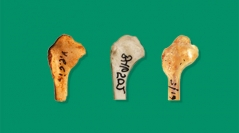

 Comptes Rendus Palevol
21 (11) - Pages 235-244
Comptes Rendus Palevol
21 (11) - Pages 235-244Buttonquails (Turnicidae) are morphologically derived, quail-like members of the avian order Charadriiformes (shorebirds) that live in Old World dry tropical and subtropical open habitats. The morphological disparity between modern buttonquails and other shorebirds is bridged by Paleogene stem-group turnicids, which have a less specialised morphology. However, there is currently a large temporal gap in the fossil record between the earliest European buttonquails (early Oligocene) and the youngest pre-Quaternary records (late Miocene). Here we describe two new taxa from France, based on partial humeri, which we refer to Turnicidae gen. et sp. indet. The oldest record stems from deposits from the latest Oligocene, which are part of the Saint-Gérand-le-Puy fossil sites. The younger record is from the early-middle Miocene fissure filling of Vieux-Collonges. In morphology, both taxa are more similar to early Oligocene species of Turnipax Mayr, 2000 than to crown-group turnicids. Although the fossils are too fragmentary to allow ecomorphological interpretations, paleoenvironmental data suggest that, like Paleogene buttonquails, these taxa departed from the adaptations to open arid environments by modern-type turnicids. Our assessments therefore reinforce previous hypotheses that crown-group turnicids probably did not diversify before the late Miocene, and argue in favour of broader ecological preferences in stem-group turnicids.
Fossil birds, shorebird evolution, Miocene aridification, French fossil sites, palaeobiology